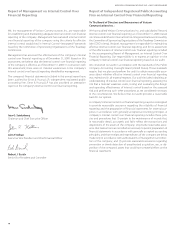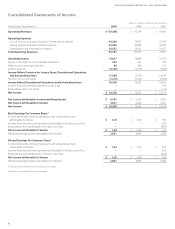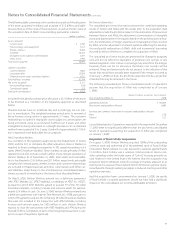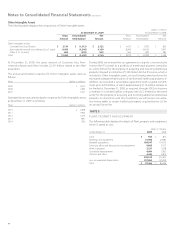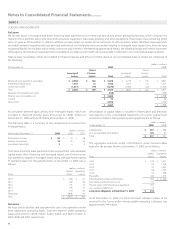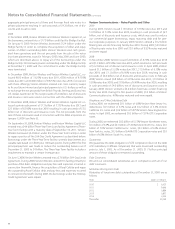Verizon Wireless 2009 Annual Report Download - page 51
Download and view the complete annual report
Please find page 51 of the 2009 Verizon Wireless annual report below. You can navigate through the pages in the report by either clicking on the pages listed below, or by using the keyword search tool below to find specific information within the annual report.Notes to Consolidated Financial Statements continued
49
Stock-Based Compensation
We measure and recognize compensation expense for all stock-based
compensation awards made to employees and directors based on esti-
mated fair values. See Note 11 for further details.
Foreign Currency Translation
The functional currency of our foreign operations is generally the local
currency. For these foreign entities, we translate income statement
amounts at average exchange rates for the period, and we translate
assets and liabilities at end-of-period exchange rates. We record these
translation adjustments in Accumulated other comprehensive loss, a
separate component of Equity, in our consolidated balance sheets. We
report exchange gains and losses on intercompany foreign currency
transactions of a long-term nature in Accumulated other comprehensive
loss. Other exchange gains and losses are reported in income.
Employee Benefit Plans
Pension and postretirement health care and life insurance benefits earned
during the year as well as interest on projected benefit obligations are
accrued currently. Prior service costs and credits resulting from changes
in plan benefits are amortized over the average remaining service period
of the employees expected to receive benefits. Expected return on
plan assets is determined by applying the return on assets assumption
to the market-related value of assets. Verizon management employees
no longer earn pension benefits or earn service towards the company
retiree medical subsidy (see Note 12).
We recognize a defined benefit postretirement plan’s funded status
as either an asset or liability on the consolidated balance sheets. Also,
we measure any unrecognized actuarial gains and losses and prior ser-
vice costs and credits that arise during the period as a component of
Accumulated other comprehensive loss, net of applicable income tax.
Derivative Instruments
We have entered into derivative transactions primarily to manage our
exposure to fluctuations in foreign currency exchange rates, interest rates,
equity and commodity prices. We employ risk management strategies,
which may include the use of a variety of derivatives including cross cur-
rency swaps, foreign currency and prepaid forwards and collars, interest
rate and commodity swap agreements and interest rate locks. We do not
hold derivatives for trading purposes.
We measure all derivatives, including derivatives embedded in other
financial instruments, at fair value and recognize them as either assets or
liabilities on our consolidated balance sheets. Our derivative instruments
are valued primarily using models based on readily observable market
parameters for all substantial terms of our derivative contracts and thus
are classified as Level 2. Changes in the fair values of derivative instru-
ments not qualifying as hedges or any ineffective portion of hedges are
recognized in earnings in the current period. Changes in the fair values
of derivative instruments used effectively as fair value hedges are recog-
nized in earnings, along with changes in the fair value of the hedged item.
Changes in the fair value of the effective portions of cash flow hedges are
reported in Other comprehensive income (loss) and recognized in earn-
ings when the hedged item is recognized in earnings.
Recently Adopted Accounting Standards
On January 1, 2009, we adopted the accounting standard relating
to business combinations, including assets acquired and liabilities
assumed arising from contingencies. This standard requires the use of
the acquisition method of accounting, defines the acquirer, establishes
the acquisition date and applies to all transactions and other events in
which one entity obtains control over one or more other businesses.
Upon our adoption of this standard, we were required to expense certain
transaction costs and related fees associated with business combinations
that were previously capitalized. In addition, with the adoption of this
standard, changes to valuation allowances for acquired deferred income
tax assets and adjustments to unrecognized tax benefits acquired
generally are to be recognized as adjustments to income tax expense
rather than goodwill.
The adoption of the following accounting standards and updates during
2009 did not result in a significant impact to our consolidated financial
statements:
On January 1, 2009, we adopted the accounting standard relating to
disclosures about derivative instruments and hedging activities, which
requires additional disclosures that include how and why an entity uses
derivatives, how these instruments and the related hedged items are
accounted for and how derivative instruments and related hedged items
affect the entity’s financial position, results of operations and cash flows.
On January 1, 2009, we adopted the accounting standard that modifies
the determination of the useful life of intangible assets from a require-
ment to consider whether an intangible asset can be renewed without
substantial cost or material modifications to the existing terms and condi-
tions to one that requires an entity consider its own historical experience
in renewing similar arrangements, or a consideration of market partici-
pant assumptions in the absence of historical experience. This standard
also requires disclosure of information that enables users of financial
statements to assess the extent to which the expected future cash flows
associated with the asset are affected by the entity’s intent and ability to
renew or extend the arrangements.
On June 15, 2009, we prospectively adopted the accounting standard
regarding the accounting for, and disclosure of, events that occur after
the balance sheet date but before the financial statements are issued.
On June 15, 2009, we adopted the accounting standard that amends the
requirements for disclosures about fair value of financial instruments for
annual, as well as interim, reporting periods. This standard was effective
prospectively for all interim and annual reporting periods ending after
June 15, 2009.
On June 15, 2009, we prospectively adopted the accounting standard
that amends requirements for recognizing and measuring other-than-
temporary impairment of debt securities classified as held to maturity or
available for sale. The presentation and disclosure requirements apply to
both debt and equity securities.
On June 15, 2009, we prospectively adopted the accounting standard
regarding estimating fair value measurements when the volume and
level of activity for the asset or liability has significantly decreased, which
also provides guidance for identifying transactions that are not orderly.
On August 28, 2009, we adopted the accounting standard update
regarding the measurement of liabilities at fair value. This standard
update provides techniques to use in measuring fair value of a liability in
circumstances in which a quoted price in an active market for the iden-
tical liability is not readily available.
In December 2008, the accounting standard regarding employers’ disclo-
sures about postretirement benefit plan assets was updated to require us,
as a plan sponsor, to provide disclosures about plan assets, including cat-
egories of plan assets, the nature of concentrations of risk and disclosures
about fair value measurements of plan assets, which became effective as
of December 31, 2009.



